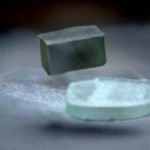September was one of those months that I wonder whether there have been really many news or if I just spend too much time on the internet. Let’s start from the items concerning particles and atoms, so that you hopefully get to read them, and go on with the spectacular space news, from the closest to the most distant ones.
And just because it’s super hot and I can’t stop playing with it, I’ll have an AI-generated illustration (by Dall-E Mini) for each piece of news. Sorry, I’m not sacrificing Midjourney credits for this blog yet.
Measuring electrons, better than ever

The Standard Model is the theory describing the world of subatomic particles and the forces between them. It’s also the most successful scientific theory (so, the most successful theory) in history, if we judge by the agreement between its predictions for the properties of particles and what the experiments have measured. I don’t hide that I’m a fan of the “SM”, and if you want to read just a little more about it you can click here.
Now, the recent news isn’t about any new discovery in or outside the SM. But it is about the most precise of precise SM measurements to date. This is for the magnetic moment of the electron (basically its magnetic field) which took place at the Northwestern University in USA. The measurement agrees with the prediction to 1 part in 1012, and made for one more nice small occasion to celebrate that great model.
Too many news you said? Let’s retract some
Two years ago scientists announced that they did superconductivity at a whooping 15°C. Read about the impressive details at that time’s post.

Or, maybe, don’t read them. That announcement is now thought to have some serious issues and it was taken back by Nature, the journal that published it. Problems with how measurement noise was removed from useful data, and a few other things, showed up after the publication.
Gross, but I had to write about it, for those of you who had secretly believed in the room-temperature superconductivity hope after that uplifting but false news. That’s science and the scientific method for you.
Water in asteroids

Time sure flies when you’re having fun. This blog has followed JAXA’s spacecraft Hayabusa-2 since it arrived to asteroid Ryugu 300 million kilometers from Earth, when it took a fistful of its soil, when it returned to Earth orbit, during the analysis of the soil sample … and now suddenly it’s already time for a discovery: A drop of water was found in the sample of dirt. More precisely, the analysis team said that it was “carbonated water containing salt and organic matter”. Apart from sounding neat, this supports the theory of water having maybe arrived to Earth through collisions of asteroids.
Fun with asteroids

It was also three years ago when we first wrote about something that was going to happen in the distant 2022. And it just happened. That feels weird. Anyway, NASA’s DART spacecraft successfully crashed on the asteroid Dimorphos.
The idea is to see whether such a crash can slightly change an asteroid’s orbit. Just to be prepared in case, you know, one of these flies a little too close to Earth in the future.
It remains to calculate if the orbit changed, which will be done through the observations of the little cubesat LICIACube which is at it as we speak.
James Webb awesomeness
The James Webb Space Telescope news of the month: its first direct photos of an exoplanet and a totally crazy pic of Neptune with its rings. (No, no AI-generated thumbnails for this one. Click on the links.)
Radio mysteries
Fast radio bursts aka FRBs are one of the hottest topics in astrophysics. FRBs are very powerful radiowave emissions; we’re talking the equivalent of thousands of suns in terms of energy, all sent out in a fraction of a second. Add to this the fact that FRBs are outside the Milky Way, that some hundreds have been found and that they have no explanation so far, and you have an explosive cocktail. (And they pop up in the news so often that I’ll just keep pasting this whole paragraph from an older post in this blog.)

Now China’s FAST, the largest radiotelescope in the world, may have found an explanation. Watching closely a specific FRB, the FAST researchers realized that its signal has features reminding of a weird couple seen a few times in our Milky Way: a binary system of a star and a magnetar.
A magnetar is a weird form of dead star left behind after a supernova. It is actually a neutron star, one of those super-dense objects, only with magnetic fields several thousands of times larger than those of “ordinary” neutron stars. The gigantic battle between the magnetic force and gravity distorts the star’s shape; massive starquakes shake it and huge stellar flares are thrown into space. And this paragraph is also pasted from an older post, written when a magnetar was also hypothesized to be the source of an FRB within the Milky Way itself.
The new thing now is that the radiowaves from a magnetar are hypothesized to pass by its companion star before travelling our way. Without getting into much detail, the companion has to belong to a specific star type which is surrounded by a detached disk of gas. The combination of the magnetar’s emission with the passage through the disk probably creates the special features seen in FRB signals. And connecting the mysterious pals to magnetars twice already probably has something good to say for solving their mystery.
